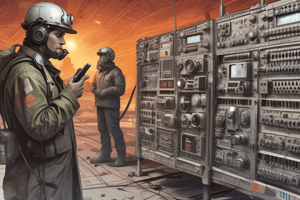Podcast
Questions and Answers
Everyone at an emergency scene should follow two basic communications rules, the first of which is?
Everyone at an emergency scene should follow two basic communications rules, the first of which is?
- Key the microphone and wait a second or two before starting your message.
- Always state your message twice to ensure its understanding.
- Units or individuals must identify themselves in every transmission. (correct)
- Hold the microphone as close as possible to your mouth when speaking.
A separate dispatch center operated by a fire department would be categorized as a(an):
A separate dispatch center operated by a fire department would be categorized as a(an):
- Public Safety Answering Point (PSAP).
- Emergency Service Specific Telecommunications Center. (correct)
- Tertiary Public Safety Answering Point (TSAP).
- Regional Public Safety Telecommunications Center.
What information should be included when broadcasting information on emergencies to department members?
What information should be included when broadcasting information on emergencies to department members?
- Information from neighboring jurisdictions and state law enforcement
- Information from area businesses and media outlets
- Information from the caller and from preincident plans (correct)
- Information from the caller and historical incidents
What information should be gathered by a dispatcher?
What information should be gathered by a dispatcher?
To provide better performance than other radios, base stations have receivers that are:
To provide better performance than other radios, base stations have receivers that are:
Which channel would be assigned for fireground operations only?
Which channel would be assigned for fireground operations only?
All recorded transmissions become part of the official record on an incident and may be made public under open records laws or _____ requests.
All recorded transmissions become part of the official record on an incident and may be made public under open records laws or _____ requests.
Which is a guideline for receiving nonemergency calls?
Which is a guideline for receiving nonemergency calls?
Which type of alarm consists of scrolling message boards and pagers?
Which type of alarm consists of scrolling message boards and pagers?
Experience at emergency incidents has shown that, in addition to background noise, _____ can significantly affect the ability to hear and understand radio transmissions.
Experience at emergency incidents has shown that, in addition to background noise, _____ can significantly affect the ability to hear and understand radio transmissions.
Communications equipment that is to be used in flammable atmospheres must be:
Communications equipment that is to be used in flammable atmospheres must be:
Which type of communications center equipment would be used for communications at an emergency scene?
Which type of communications center equipment would be used for communications at an emergency scene?
Which is a radio communications best practice?
Which is a radio communications best practice?
Often referred to as dispatchers, the persons who are trained to answer emergency calls and obtain the correct information are:
Often referred to as dispatchers, the persons who are trained to answer emergency calls and obtain the correct information are:
Fire department radio channels should NOT be used:
Fire department radio channels should NOT be used:
At the station, if you cannot answer a caller's question, refer them to someone who can, then:
At the station, if you cannot answer a caller's question, refer them to someone who can, then:
Static and broken messages are an indication that a radio receiver is:
Static and broken messages are an indication that a radio receiver is:
To overcome physical barriers to radio communication, you may need to turn your body 90 degrees or:
To overcome physical barriers to radio communication, you may need to turn your body 90 degrees or:
When receiving a call from someone who is angry or upset:
When receiving a call from someone who is angry or upset:
Modern 9-1-1 system capabilities now include _____ and smartphone apps.
Modern 9-1-1 system capabilities now include _____ and smartphone apps.
What federal agency regulates all radio communication in the United States?
What federal agency regulates all radio communication in the United States?
To improve your ability to hear and be heard at an emergency incident:
To improve your ability to hear and be heard at an emergency incident:
Which category of telecommunications system is in a central location, takes all emergency calls, and then routes calls to appropriate dispatchers?
Which category of telecommunications system is in a central location, takes all emergency calls, and then routes calls to appropriate dispatchers?
The use of plain English in radio communications transmissions and avoidance of 10-codes is known as using:
The use of plain English in radio communications transmissions and avoidance of 10-codes is known as using:
Calls received at fire department facilities that range from requests for assistance to personal calls from family or friends are known as _____ calls.
Calls received at fire department facilities that range from requests for assistance to personal calls from family or friends are known as _____ calls.
Emergency calls to a telecommunications center must be handled quickly in order to:
Emergency calls to a telecommunications center must be handled quickly in order to:
Which term refers to remote areas or locations inside structures that can cause loss of cellular telephone service or radio signals?
Which term refers to remote areas or locations inside structures that can cause loss of cellular telephone service or radio signals?
What communication center equipment is used to receive calls from individuals with hearing impairments?
What communication center equipment is used to receive calls from individuals with hearing impairments?
Using your PPE to create a wind barrier when transmitting on a portable radio is a means to deal with:
Using your PPE to create a wind barrier when transmitting on a portable radio is a means to deal with:
Once an emergency has been reported, the information must be:
Once an emergency has been reported, the information must be:
The straight line travel of radio signals between the transmitting radio and the receiving radio is referred to as _____ communication.
The straight line travel of radio signals between the transmitting radio and the receiving radio is referred to as _____ communication.
Flashcards are hidden until you start studying
Study Notes
Communication Protocols
- At emergency scenes, individuals must identify themselves in every transmission for clarity.
- Key the microphone and wait a moment before starting a message to mitigate cutting off the beginning of transmissions.
Dispatch Centers
- Emergency Service Specific Telecommunications Centers are separate dispatch centers managed by fire departments.
Information Relay
- Essential information for broadcasting includes data from the caller and preincident plans.
- Dispatchers should gather the number and location of people involved in an incident.
Radio Performance and Channels
- Base station receivers are designed to be interference resistant for superior performance.
- Tactical channels are designated specifically for fireground operations.
Recording and Call Handling
- All recorded transmissions may be publicly disclosed under the Freedom of Information Act.
- Nonemergency calls should be answered promptly, ensuring efficient communication.
Alarm Systems
- Electronic alarms utilize scrolling message boards and pagers for alerting.
Communication Challenges
- Personal protective equipment can hinder the ability to hear radio transmissions effectively.
- Communications equipment must be intrinsically safe for use in flammable atmospheres.
Emergency Radio Practices
- Two-way radio systems are essential for communication during emergencies.
- Best radio practice includes not transmitting until the frequency is clear to avoid overlaps.
Dispatcher Roles
- Telecommunicators are trained personnel who manage emergency calls and gather vital information from callers.
Proper Equipment Usage
- Fire department channels should not be used for personal messages to maintain professionalism.
- Always follow up on calls if unable to provide immediate answers to inquiries.
Radio Communication Techniques
- Static and broken messages indicate the receiver is likely near the limit of transmission range.
- To enhance communication, raise the antenna straight to overcome physical barriers.
Handling Upset Callers
- Maintain a pleasant demeanor when speaking to upset callers and collect necessary information.
Modern 9-1-1 Capabilities
- Current 9-1-1 systems support text messaging alongside voice calls.
Federal Regulations
- The Federal Communications Commission regulates all radio communications in the U.S.
Enhancing Understandability
- If communication is unclear through a facepiece, position the microphone against the throat for better clarity.
Telecommunications System Types
- The Public Safety Answering Point (PSAP) centralizes emergency calls and routes them to appropriate dispatchers.
Clear Communication Practices
- Using clear text instead of 10-codes enhances comprehension in radio communications.
Types of Emergency Calls
- Nonemergency calls can include a range from requests for help to personal inquiries.
Timeliness and Community Safety
- Rapid handling of emergency calls is crucial for ensuring community safety.
Areas Affecting Signal Quality
- Dead zones are locations within structures or remote areas that cause loss of radio or cellular signals.
Equipment for Hearing Impaired
- Teletype systems are employed to facilitate communication for individuals with hearing impairments.
Dealing with Ambient Noise
- Utilize personal protective equipment to create a wind barrier when transmitting on a portable radio to mitigate ambient noise.
Emergency Response Initiation
- Information about an emergency must be quickly transmitted to responding units after being reported.
Direct Communication
- Direct communication refers to the straight-line travel of radio signals between transmitter and receiver.
Studying That Suits You
Use AI to generate personalized quizzes and flashcards to suit your learning preferences.




